Education
What does the research show on school choice?
Greg Forster, Ph.D. | April 29, 2019
Executive Summary
One of the most important and hotly contested questions about school choice—policies that allow parents to select any school, public or private, for their children to attend using their public education funding—is what the empirical research shows its effects are. This policy brief builds upon the author’s previous work reviewing the empirical literature on the effects of school choice on academic outcomes (for participants and public schools), fiscal effects, and concerns about segregation and civics. It finds a strong consensus in the research in favor of positive effects from school choice in all these areas. (see Figure 1)
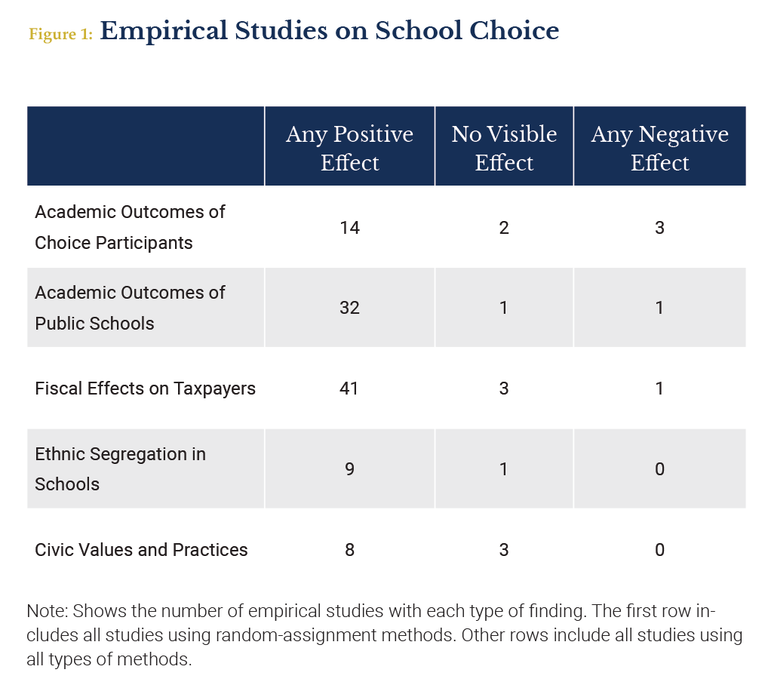
I. Myths v. Facts on School Choice
Almost from the very beginning of the modern school choice movement in 1990, with the creation of a school voucher program in Milwaukee, proponents and opponents of private-school choice have made competing claims about what the research shows its effects to be. Proponents have asserted that the research favors school choice, while opponents have consistently claimed that the research is “mixed” or else negative.
Even if one study finds a small positive effect while another study finds a large positive effect, the studies are “mixed” with regard to the size of the benefits. However, on the question that counts most—do school choice policies produce positive effects?—the answer is consistently “yes.”
Oklahoma recently encountered a clear example of this, with the distribution this spring of a press release authored by two academics. Titled “Privatizing K-12 Public Education,” the press release made sweeping claims about alleged negative findings in the empirical research on various forms of school choice. These claims were either misleading (it made a big deal of saying no “independent” studies of a voucher program in Washington, D.C. had found positive outcomes; apparently the huge, top-quality federal study finding positive outcomes was arbitrarily deemed to be non-“independent,” so no mention was made of it) or outright false (it claimed “privatized schools tend to segregate children,” whereas we will see below that no empirical study has ever shown this, while many show the opposite).[1]
Over the years, I have conducted a series of systematic literature reviews (published by EdChoice, where I serve as a Friedman fellow) examining the empirical research on school choice. The reviews are entitled “A Win-Win Solution,” reflecting the fact that the research finds school choice has positive effects not only for participants, but for public schools, taxpayers, and the civic community as well. The most recent of these reviews was published in 2016.[2] In that review I adopted my most rigorous method yet for uncovering all available studies, conducting methodical searches of academic databases.
While I have not conducted that kind of systematic review since that publication, in this policy brief I have used my 2016 review as a starting point and then added such studies as I have become aware of since then. I have retained the other methods I adopted in the 2016 review, including (for example) the rules I used for judging when two analyses constituted two separate studies, as opposed to one study that reports two findings. Readers interested in these methodological issues should consult that publication.
II. The Research on Academic Effects
Academic effects may be the most important empirical question we ask about school choice. At one time, it was by far the most hotly debated, whereas today it is much less frequently mentioned by opponents of choice. Having been in the school choice movement since 2002, I can remember when we constantly heard claims that “there’s no evidence school choice actually helps kids learn” or “the research on outcomes is mixed.” Such claims were a primary focus in the 2005 book Education Myths, which I co-wrote.[3] We almost never hear that kind of thing now, because the research on academic outcomes is so consistently positive.
Most of these studies examine test scores, although a handful look at other metrics such as high-school graduation rates and college attendance rates. Recent research has called into question the value of test scores as a measurement of academic outcomes. This research finds little or no connection between improvements in K-12 test scores and improvements in long-term life outcomes, in contrast to high-school graduation and college enrollment (which do seem to be more strongly associated with long-term life outcomes).[4] This limitation is worth keeping in mind.
Academic Effects on Participants
The most obvious question about academic effects is how school choice participants are affected. Here, we are fortunate that a large body of research exists using the “gold standard” method of random assignment. This method is familiar to many from medical trials, where subjects are randomly assigned to a treatment group and a control group (which gets a placebo). In many school choice programs, parents who apply to the program are selected to participate by a random lottery. This gives us a naturally occurring random-assignment experiment design, allowing us to compare choice participants with a population of students that is the same except for random chance. Where a large body of this type of research exists, it ought to take priority over other research.
Across all 19 random-assignment studies I’ve found, 14 found positive effects for participating students. Two found no visible effect and three found negative effects. The size of the positive effects varies from study to study, but is generally moderate in scale—real but not revolutionary improvement. The negative effects found of a voucher program in Louisiana, by contrast, are large. Meanwhile, a voucher program in Washington, D.C. had both positive and negative findings on different metrics (test scores were moderately negative while high-school graduation rates and college enrollment rates showed a large positive effect). (see Figure 2)
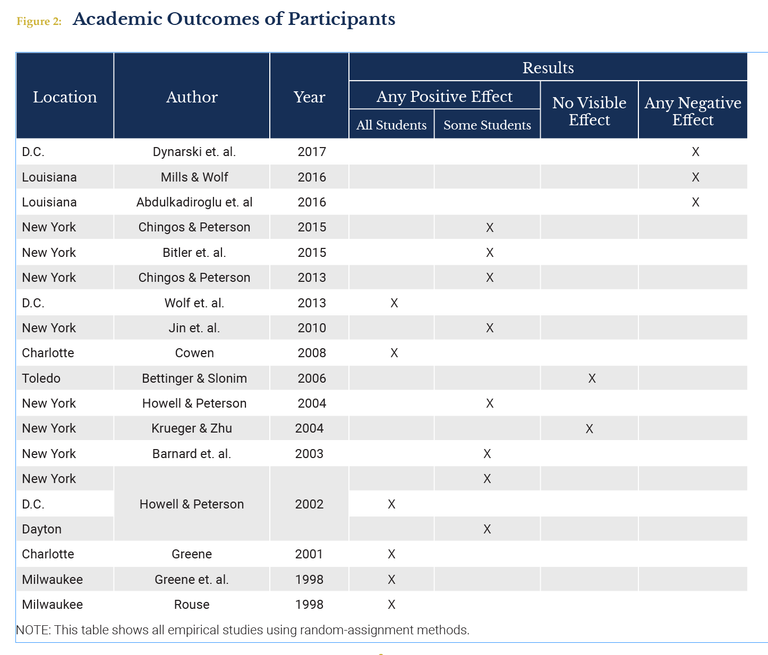
Academic Effects on Public Schools
While participant effects are of obvious interest, many more students are impacted by school choice programs through their impact on public schools. If choice programs harm public schools, as opponents claim is the case due to draining of funds and creaming of the best students, they might be a counterproductive policy even if they help the students who use them. On the other hand, if they help public schools by holding them accountable to parents, as advocates claim, that will produce a much wider positive effect than just the impact on participants—since there are still many more public school students than school choice students even where choice programs have grown to considerable size.
The research consistently finds that school choice improves academic outcomes in public schools. Including all studies using all methods (for it is impossible to study this question using random assignment), I’ve found 34 empirical studies. Of these, 32 find that school choice improves academic outcomes in public schools affected by the program, while one finds no visible difference and one finds a negative impact. (see Figure 3)
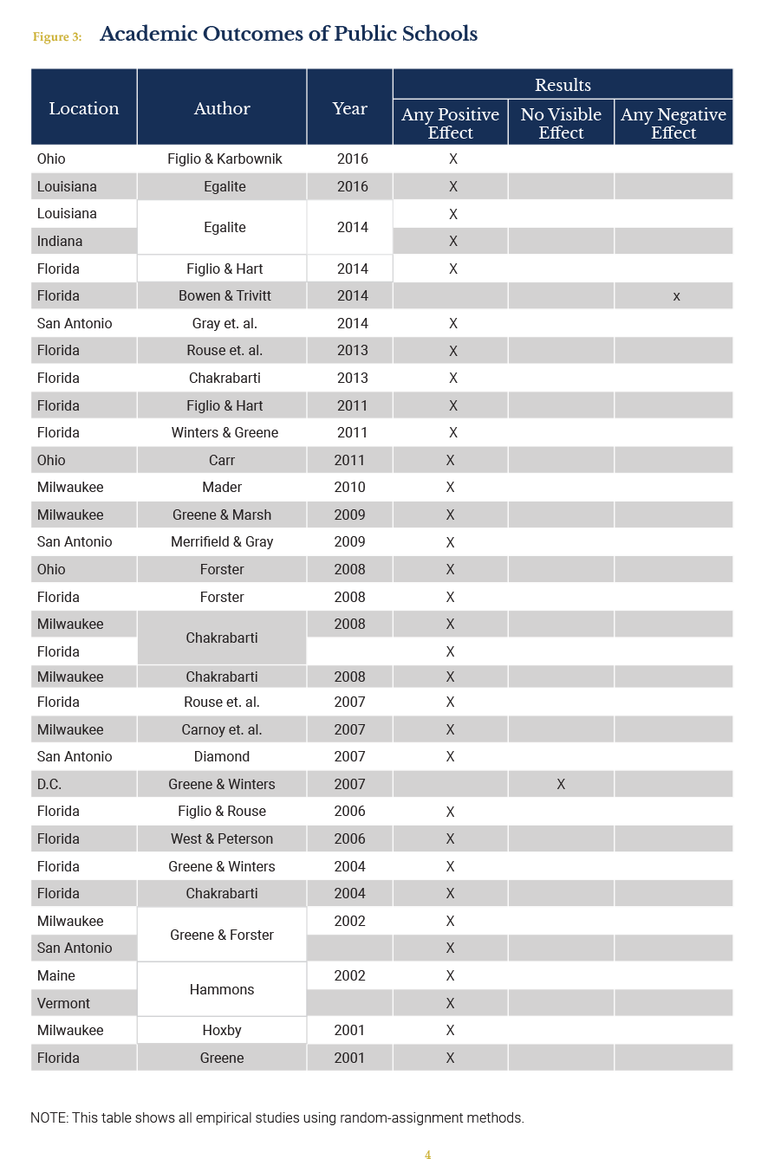
III. The Research on Fiscal Effects
Obviously we care about more than just academic effects in education policy. One major variable to be considered is the fiscal effect of these programs on taxpayers. Cost is a concern in every public policy, and especially in education as school budgets—which had expanded steadily in real terms not only for decades, but for generations—have come under increasing pressure in recent years.
Fiscal effects can be complex to track. One factor to bear in mind is that the same program can create different fiscal effects at different budgetary levels (local and state). This review tracks the total net effect of school choice programs for taxpayers across all levels.
Also, it is important to remember that a program that saves money for taxpayers does not necessarily leave public schools in worse fiscal shape on a per-student basis. This is especially true because large portions of education funding come from local sources (such as property taxes) and federal programs that usually don’t go down when the student population decreases. So schools that lose students to choice programs often save more money in reduced education expenses than they lose in revenue associated with the student—they lose only the state portion of student funding, not the local or federal portion, but they lose 100% of the variable expenses associated with educating the student.[5]
Looking at all studies, I have found 45 studies that examine the fiscal effect of school choice programs for taxpayers. Of these, 41 found that school choice saves money for taxpayers, three find no visible difference and one finds a net cost to taxpayers. The net-cost study looked at a choice program serving special-education students in Louisiana, finding that on net it had cost taxpayers $91 per student since its creation; the same researcher found net savings per student in other programs ranging from $820 to $7,322. (see Figure 4)
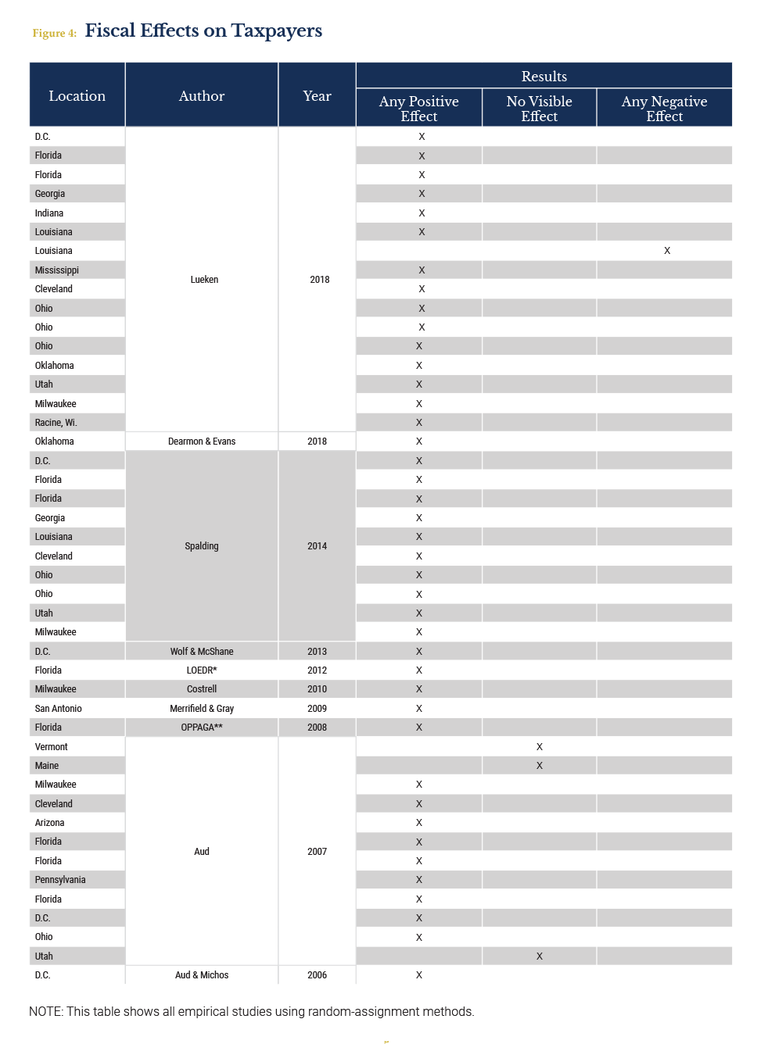
IV. The Research on Segregation and Civics
The public good is not all about dollars and cents. In addition to academic outcomes and the fiscal cost of education, we care about the civic health of the polity. Two key areas of civic concern are ethnic segregation and whether schools are teaching students strong civic values and practices.
Effects on Ethnic Segregation
Ethnic segregation is an important concern in education. Government-run school systems in the U.S. have a terrible history of practicing overt and covert ethnic segregation, and high levels of residential segregation tend to produce continuing school segregation as long as students are assigned to schools based on where they live. The continued existence of ethnically homogenous schools raises concerns that range from basic issues of justice (are old patterns of discrimination and white supremacy being perpetuated by surreptitious means?) to the nature of students’ educational experience (are students in homogenous schools being adequately prepared for the kind of pluralistic, multi-ethnic society demanded by the American experiment?)
Unfortunately, most empirical studies that look at segregation use inappropriate methods that do not actually measure the ethnic segregation of schools. Typical methods, like the Gini coefficient, measure how the ethnic makeup of each individual school compares to the ethnic makeup of its school district. However, school district lines are themselves drawn in ways that perpetuate segregation. Using the Gini coefficient, we can miraculously show that every 99%-white school in a 99%-white school district is perfectly integrated, even if that district is right next door to a district that is 99% minority. Jay Greene issues a fitting verdict on what such methods are really telling us: “The schools are well integrated, given that they are horribly segregated.”[6]
Valid methods measure segregation either by comparing schools to populations with boundaries drawn independently of the school system (such as Census-designated metropolitan areas), or by measuring racial isolation (looking at whether schools are, for example, over 90% white or over 90% minority). Other methodological concerns include comparing schools at the same grade levels, because primary schools draw from smaller (and therefore more ethnically homogenous) geographic areas. Some studies measure whether school choice has a causal effect that increases or decreases segregation levels over time, while other studies look descriptively at whether school choice is moving students from more segregated to less segregated classrooms (or vice versa).
Looking at all studies that use valid methods to measure ethnic segregation, I find a total of 10 studies. Of these, nine had positive findings and one found no visible effect. No study has found a negative effect. It appears that, far from parents seeking out segregated schools, detaching school attendance from geographic location improves the ethnic mixing of students. (see Figure 5)
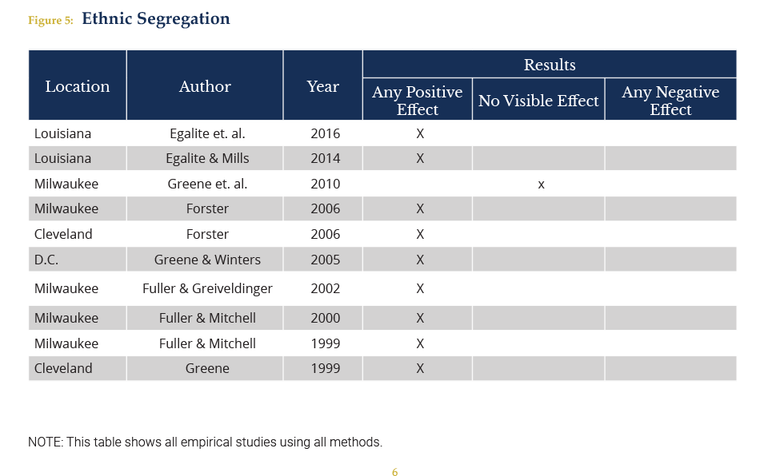
Effects on Civic Values and Practices
Education researchers have found a number of ways to measure the effect of schools on civic values and practices. One of the most common is to measure tolerance for the rights of others; researchers typically ask students to identify their most-disliked group, and then ask whether the students would support the rights of that group to vote, organize marches, have books sympathetic to their views in the library, etc. Other measurements include the rates at which students vote and volunteer their time after graduation.
Including all studies with all methods, I’ve found 11 studies on how school choice programs affect civic values and practices. Of these, eight find positive effects from school choice and three find no visible effect. No study has found a negative effect. It appears that, far from being bastions of anti-democratic sentiment or civic isolation, private schools are highly effective in teaching tolerance and democratic participation as moral imperatives. (see Figure 6)
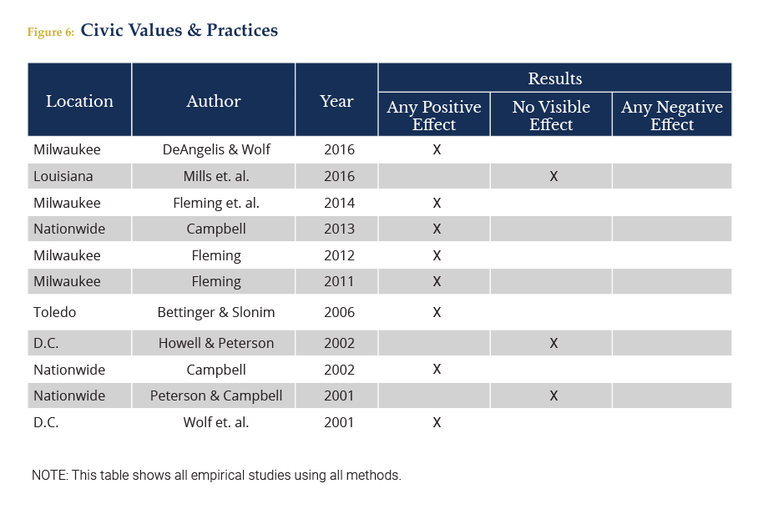
V. Policy Recommendations
School choice policies are better supported by empirical evidence than any other kind of education reform. Of course, questions still remain and there is much for future research to tell us. However, the current state of the research places us far beyond the point where an initial verdict is not only possible, but clearly demanded.
Several conclusions for policy consideration are suggested by this review:
- Existing school choice programs are under regular threat of repeal and even administrative sabotage from hostile regulators.[7] Policymakers should protect school choice programs, given their positive effects.
- Policymakers should carefully consider how best to expand school choice programs. Nationwide, these policies are moving beyond the pilot-test phase to larger-scale programs; given the empirical support for their positive effects, that movement should be welcomed.
- Design flaws in existing programs should be studied so they are not repeated. Of the three negative findings on academic effects for participants, one comes from a program (in Washington, D.C.) where positive effects have also been found in other analyses. By contrast, two negative studies examine Louisiana’s voucher program, whose design flaws became a subject of much discussion in the school choice movement as soon as the negative studies appeared.[8] Policymakers should identify key flaws not to reproduce in future programs.
Appendix
Studies of Academic Effects on Participating Students
Abdulkadiroglu, Atila, Parag A. Pathak, and Christopher R. Walters. “School Vouchers and Student Achievement: First-Year Evidence from the Louisiana Scholarship Program.” NBER Working Paper 21839. Cambridge, MA: National Bureau of Economic Research, 2015.
Barnard, John, Constantine E. Frangakis, Jennifer L. Hill, and Donald B. Rubin. “PrincipalStratification Approach to Brok en Randomized Experiments: A Case Study of School Choice Vouchers in New York City.” Journal of the American Statistical Association 98, no. 462 (June 2003), p. 299-323.
Bettinger, Eric and Slonim, Robert. “Using Experimental Economics to Measure the Effects of a Natural Educational Experiment on Altruism.” Journal of Public Economics 90 (2006), p. 1625-1648.
Bitler, Marianne, Thurston Domina, Emily Penner, and Hilary Hoynes. “Distributional Effects of a School Voucher Program: Evidence from New York City.” Journal of Research on Educational Effectiveness 8, no. 3 (July-Sept. 2015), p. 419-50.
Chingos, Matthew M., and Paul E. Peterson. “Experimentally Estimated Impacts of School Vouchers on College Enrollment and Degree Attainment.” Journal of Public Economics 122 (Feb. 2015), pp. 1-12.
Chingos, Matthew M., and Paul E. Peterson. “The Impact of School Vouchers on College Enrollment.” Education Next 13, no. 3 (Summer 2013), p. 59-64.
Cowen, Joshua M. “School Choice as a Latent Variable: Estimating the ‘Complier Average Causal Effect’ of Vouchers in Charlotte.” Policy Studies Journal 36, no. 2 (May 2008), p. 301-15.
Dynarski, Mark, Ning Rui, Ann Webber and Babette Gutmann, “Evaluation of the D.C. Opportunity Scholarship Program,” Institute of Education Sciences, April 2017.
Greene, Jay P. “Vouchers in Charlotte,” Education Next 1, no. 2 (Summer 2001), p. 55-60.
Greene, Jay P., Paul E. Peterson, and Jiangtao Du. “Effectiveness of School Choice: The Milwaukee Experiment.” Education and Urban Society 31, no. 2 (Jan. 1999), p. 190-213.
Howell, William G., and Paul E. Peterson. The Education Gap: Vouchers and Urban Schools. Rev. ed. Washington, DC: Brookings Institution, 2006.
Jin, Hui, John Barnard, and Donald B. Rubin. “A Modified General Location Model for Noncompliance with Missing Data: Revisiting the New York City School Choice Scholarship Program using Principal Stratification.” Journal of Educational and Behavioral Statistics 35, no. 2 (Apr. 2010), p. 154-73.
Krueger, Alan B., and Pei Zhu. “Another Look at the New York City School Voucher Experiment.” American Behavioral Scientist 47, no. 5 (Jan. 2004), p. 658-98.
Mills, Jonathan N., and Patrick J. Wolf. The Effects of the Louisiana Scholarship Program on Student Achievement after Two Years. Louisiana Scholarship Program Evaluation Report 1. Fayetteville: Univ. of Ark., School Choice Demonstration Project; New Orleans: Tulane Univ. Education Research Alliance, 2016.
Peterson, Paul E., and William G. Howell. “Voucher Research Controversy: New Looks at the New York City Evaluation.” Education Next 4, no. 2 (Spring 2004), p. 73-78.
Rouse, Cecilia E. “Private School Vouchers and Student Achievement: An Evaluation of the Milwaukee Parental Choice Program.” Quarterly Journal of Economics 113, no. 2 (May 1998), p. 553-602.
Wolf, Patrick J., Brian Kisida, Babette Gutmann, Michael Puma, Nada Eissa, and Lou Rizzo. “School Vouchers and Student Outcomes: Experimental Evidence from Washington, DC.” Journal of Policy Analysis and Management 32, no. 2 (Spring 2013), p. 246-70.
Studies of Academic Effects on Public Schools
Bowen, Daniel, and Julie Trivitt. “Stigma without Sanctions: The (Lack of) Impact of Private School Vouchers on Student Achievement.” Education Policy Analysis Archives 22, no. 87 (Aug. 2014), p. 1-19.
Carnoy, Martin, Rank Adamson, Amita Chudgar, Thomas F. Luschei, and John F. Witte. Vouchers and Public School Performance: A Case Study of the Milwaukee Parental Choice Program. Washington, DC: Economic Policy Institute, 2007.
Carr, Matthew. “The Impact of Ohio’s EdChoice on Traditional Public School Performance.” Cato Journal 31, no. 2 (Spring/Summer 2001), p. 257-84.
Chakrabarti, Rajashri. “Can Increasing Private School Participation and Monetary Loss in a Voucher Program Affect Public School Performance? Evidence from Milwaukee.” Journal of Public Economics 92, no. 5-6 (June 2008), p. 1371-93.
Chakrabarti, Rajashri. “Closing the Gap.” In “Competition Passes the Test.” Education Next 4, no. 3 (Summer 2004), p. 70.
Chakrabarti, Rajashri. “Impact of Voucher Design on Public School Performance: Evidence from Florida and Milwaukee Voucher Programs.” Staff Reports 315. New York: Federal Reserve Bank of New York, 2008.
Chakrabarti, Rajashri. “Vouchers, Public School Response and the Role of Incentives: Evidence from Florida.” Economic Inquiry 51, no. 1 (Jan. 2013), p. 500-26.
Diamond, John W. Should Texas Adopt a School Choice Program? An Evaluation of the Horizon Scholarship Program in San Antonio. Austin: Texas Public Policy Foundation, 2007.
Egalite, Anna J. The Competitive Effects of the Louisiana Scholarship Program on Public School Performance. Louisiana Scholarship Program Evaluation Report 4. Fayetteville: Univ. of Ark., School Choice Demonstration Project; New Orleans: Tulane Univ., Education Research Alliance, 2016.
Figlio, David N., and Cassandra M.D. Hart. “Competitive Effects of Means-Tested School Vouchers,” American Economic Journal: Applied Economics 6, no. 1 (Jan. 2014), p. 133-56.
Figlio, David N., and Cassandra M.D. Hart. “Does Competition Improve Public Schools? New Evidence from the Florida Tax-Credit Scholarship Program.” Education Next 11, no. 1 (Winter 2011), p. 74-80.
Figlio, David N., and Cecilia E. Rouse. “Do Accountability and Voucher Threats Improve Low-Performing Schools?” Journal of Public Economics 90, no. 1-2 (Jan. 2006), p. 239-55.
Figlio, David, and Krzysztof Karbownik, “Evaluation of Ohio’s EdChoice Scholarship Program,” Fordham Institute, July 2016.
Forster, Greg. Lost Opportunity: An Empirical Analysis of How Vouchers Affected Florida Public Schools. Indianapolis: Friedman Foundation for Educational Choice, 2008.
Forster, Greg. Promising Start: An Empirical Analysis of How EdChoice Vouchers Affect Ohio Public Schools. School Choice Issues in the State. Indianapolis: Friedman Foundation for Educational Choice, 2008.
Greene, Jay P. An Evaluation of the Florida A-Plus Accountability and School Choice Program. Civic Report. New York: Manhattan Institute, 2001.
Gray, Nathan L., John D. Merrifield, and Kerry A. Adzima. “A Private Universal Voucher Program’s Effects on Traditional Public Schools.” Journal of Economics and Finance 39, no. 1 (Dec. 2014), pp. 1–26.
Greene, Jay P., and Greg Forster. Rising to the Challenge: The Effect of School Choice on Public Schools in Milwaukee and San Antonio. New York: Manhattan Institute, 2002.
Greene, Jay P., and Ryan H. Marsh. The Effect of Milwaukee’s Parental Choice Program on Student Achievement in Milwaukee Public Schools. SCDP Comprehensive Longitudinal Evaluation of the Milwaukee Parental Choice Program Report 11. Fayetteville: Univ. of Ark., School Choice Demonstration Project, 2009.
Greene, Jay P., and Marcus A. Winters. “Competition Passes the Test.” Education Next 4, no. 3 (Summer 2004), p. 66-71.
Greene, Jay P., and Marcus A. Winters. “An Evaluation of the Effects of DC’s Voucher Program on Public School Achievement and Racial Integration after One Year.” Catholic Education: A Journal of Inquiry and Practice 11, no. 1 (Sept. 2007), pp. 83-101.
Hammons, Christopher. The Effects of Town Tuitioning in Vermont and Maine. School Choice Issues in Depth 1. Indianapolis: Milton and Rose D. Friedman Foundation, 2002.
Hoxby, Caroline M. “Rising Tide.” Education Next 1, no. 4 (Winter 2001), p. 69-74.
Jacob, Anna, and Kate Dougherty. “The Competitive Effect of the Indiana Choice Scholarship Program on Student Achievement in Indiana Public Schools.” In Jacob, “Means-Tested Vouchers: Impacts on Public School Performance and Racial Stratification,” pp. 60–88. PhD diss., Univ. of Ark., 2014. ProQuest (1561345849).
Mader, Nicholas S. “School Choice, Competition and Academic Quality: Essays on the Milwaukee Parental Choice Program” PhD diss., Univ. of Wisconsin-Madison, 2010. ProQuest (3424049).
Merrifield, John, and Nathan L. Gray. “An Evaluation of the CEO Horizon, 1998-2008, Edgewood Tuition Voucher Program.” Journal of School Choice 3, no. 4 (2009), p. 414-15.
Rouse, Cecilia E., Jane Hannaway, Dan Goldhaber, and David Figlio. “Feeling the Florida Heat? How Low-Performing Schools Respond to Voucher and Accountability Pressure.” Working Paper 13. Washington, DC: American Institutes for Research, National Center for Analysis of Longitudinal Data in Education Research, 2007.
Rouse, Cecilia E., Jane Hannaway, Dan Goldhaber, and David N. Figlio. “Feeling the Florida Heat: How Low Performing Schools Respond to Voucher and Accountability Pressure.” American Economic Journal: Economic Policy 5, no. 2 (May 2013), pp. 251–81.
West, Martin R., and Paul E. Peterson. “The Efficacy of Choice Threats Within School Accountability Systems: Results From Legislatively Induced Experiments.” Economic Journal 116, no. 510 (Mar. 2006), p. C46-62.
Winters, Marcus A., and Jay P. Greene. “Public School Response to Special Education Vouchers: The Impact of Florida’s McKay Scholarship Program on Disability Diagnosis and Student Achievement in Public Schools.” Educational Evaluation and Policy Analysis 33, no. 2 (June 2011), p. 138-58.
Studies of Fiscal Effects on Taxpayers
“Revenue Estimating Conference.” Fla. Legislative Office of Economic and Demographic Research, Mar. 16, 2012, p. 546, line 55.
Aud, Susan L. School Choice by the Numbers: The Fiscal Effect of School Choice Programs, 1990-2006. School Choice Issues in Depth. Indianapolis: Milton and Rose D. Friedman Foundation, 2007.
Aud., Susan Aud and Leon Michos. Spreading Freedom and Saving Money: The Fiscal Impact of the D.C. Voucher Program. Washington, DC:: Cato Institute; Indianapolis: Milton and Rose D. Friedman Foundation, 2006.
Costrell, Robert M. “The Fiscal Impact of the Milwaukee Parental Choice Program: 2010-2011 Update and Policy Options.” SCDP Milwaukee Evaluation Report 22. Fayetteville: Univ. of Ark., School Choice Demonstration Project, 2010.
Dearmon, Jacob, and Russell R. Evans, “Fiscal Impact Analysis of the Oklahoma Equal Opportunity Education Scholarship Act,” Oklahoma City University, 2018.
Lueken, Martin F., “Fiscal Effects of School Vouchers,” EdChoice, September 2018.
Merrifield, John, and Nathan L. Gray. “An Evaluation of the CEO Horizon, 1998-2008, Edgewood Tuition Voucher Program.” Journal of School Choice 3, no. 4 (2009), p. 414-15 .
Office of Program Policy Analysis and Government Accountability. The Corporate Tax Credit Scholarship Program Saves State Dollars. Report 08-68. Tallahassee: Fla. Legislature, Office of Program Policy Analysis and Government Accountability, 2008.
Spalding, Jeff. The School Voucher Audit: Do Publicly Funded Private School Choice Programs Save Money? Indianapolis: Friedman Foundation for Educational Choice, 2014.
Wolf, Patrick J., and Michael McShane. “Is the Juice Worth the Squeeze? A Benefit/Cost Analysis of the District of Columbia Opportunity Scholarship Program.” Education Finance and Policy 8, no. 1 (Winter 2013), p. 74-99.
Studies of Effects on Ethnic Segregation
Egalite, Anna J., and Jonathan N. Mills. “The Louisiana Scholarship Program: Contrary to Justice Department Claims, Student Transfers Improve Racial Integration.” Education Next 14, no. 1 (Winter 2014), p. 66-69.
Egalite, Anna J., Jonathan N. Mills, and Patrick J. Wolf. The Impact of the Louisiana Scholarship Program on Racial Segregation in Louisiana Schools. Louisiana Scholarship Program Evaluation Report 3. Fayetteville: Univ. of Ark., School Choice Demonstration Project; New Orleans: Tulane Univ., Education Research Alliance, 2016.
Forster, Greg. Segregation Levels in Cleveland Public Schools and the Cleveland Voucher Program. School Choice Issues in the State. Indianapolis: Milton and Rose D. Friedman Foundation; Columbus, OH: Buckeye Institute, 2006.
Forster, Greg. Segregation Levels in Milwaukee Public Schools and the Milwaukee Voucher Program. School Choice Issues in the State. Indianapolis: Milton and Rose D. Friedman Foundation, 2006
Fuller, Howard L., and Deborah Greiveldinger. “The Impact of School Choice on Racial Integration in Milwaukee Private Schools.” Aug. 2002. American Education Reform Council Manuscripts.
Fuller, Howard L., and George A. Mitchell. The Impact of School Choice on Integration in Milwaukee Private Schools. Current Education Issues 2000-02. Milwaukee, WI: Marquette Univ., Institute for the Transformation of Learning, 2000.
Fuller, Howard L., and George A. Mitchell. The Impact of School Choice on Racial and Ethnic Enrollment in Milwaukee Private Schools. Current Education Issues 99-5. Milwaukee, WI: Marquette Univ., Institute for the Transformation of Learning, 1999.
Greene, Jay P. “The Racial, Economic, and Religious Context of Parental Choice in Cleveland.” Paper presented at the Annual Meeting of the Association for Public Policy Analysis and Management, Washington, DC, Nov. 1999.
Greene, Jay P., Jonathan N. Mills, and Stuart Buck. The Milwaukee Parental Choice Program’s Effect on School Integration. SCDP Milwaukee Evaluation 20. Fayetteville: Univ. of Ark., School Choice Demonstration Project, 2010.
Greene, Jay P., and Marcus A. Winters. “An Evaluation of the Effects of DC’s Voucher Program on Public School Achievement and Racial Integration after One Year.” Catholic Education: A Journal of Inquiry and Practice 11, no. 1 (Sept. 2007), pp. 83-101.
Studies of Effects on Civic Values and Practices
Bettinger, Eric and Slonim, Robert. “Using Experimental Economics to Measure the Effects of a Natural Educational Experiment on Altruism.” Journal of Public Economics 90 (2006), p. 1625-1648.
Campbell, David E. The Civic Side of School Reform: How Do School Vouchers Affect Civic Education? Princeton, NJ: Princeton Univ., Center for the Study of Democratic Politics; Cambridge, MA: Harvard Univ., Program on Education Policy and Governance, 2002.
Campbell, David E. “The Civic Side of School Reform: Private Schools, School Vouchers and Civic Education.” Unpublished manuscript, provided by the author via email on Jan. 24, 2013.
DeAngelis, Corey and Wolf, Patrick J. “The School Choice Voucher: A ‘Get Out of Jail’ Card?” Department of Education Reform, University of Arkasnas, Working Paper 2016-03, March 8, 2016.
Fleming, David J. “Choice, Voice and Exit: School Vouchers in Milwaukee.” Paper presented at the Annual Meeting of the American Political Science Association, Sept. 2011
Fleming, David J. “Learning from Schools: School Choice, Political Learning and Policy Feedback.” Policy Studies Journal 42, no. 1 (Feb. 2014), p. 55-78.
Fleming, David J., William Mitchell, and Michael McNally, “Can Markets Make Citizens? School Vouchers, Political Tolerance, and Civic Engagement.” Journal of School Choice: International Research and Reform 8, no. 2 (2014), p. 213-36.
Howell, William G., and Paul E. Peterson. The Education Gap: Vouchers and Urban Schools. Rev. ed. Washington, DC: Brookings Institution, 2006.
Mills, Jonathan N., Albert Cheng, Collin E. Hitt, Patrick J. Wolf, and Jay P. Greene, Measures of Student Non-Cognitive Skills and Political Tolerance After Two Years of the Louisiana Scholarship Program. Louisiana Scholarship Program Evaluation Report 2. Fayetteville: Univ. of Ark., School Choice Demonstration Project; New Orleans: Tulane Univ., Education Research Alliance, 2016.
Peterson, Paul E., and David E. Campbell. An Evaluation of the Children’s Scholarship Fund. PEPG 01-03. Cambridge, MA: Harvard Univ., Program on Education Policy and Governance, 2001.
Wolf, Patrick J., Paul E. Peterson, and Martin R. West. “Results of a School Voucher Experiment: The Case of Washington, D.C. after Two Years. PEPG 01-05. Cambridge, MA: Harvard Univ., Program on Education Policy and Governance, 2001.
- [1]
Lawrence Baines and Jeannie L. Hanna, “Privatizing K-12 Public Education,” Scholars Strategy Network, undated; for a response see Greg Forster, “Setting the Record Straight on Choice,” Oklahoma Council of Public Affairs, March 27, 2019.
- [2]
Greg Forster, “A Win-Win Solution: The Empirical Research on School Choice, Fourth Edition,” EdChoice, May 2016.
- [3]
Jay P. Greene, Greg Forster and Marcus Winters, Education Myths, Rowman & Littlefield, 2005.
- [4]
For up-to-date citations to this literature, see Jay P. Greene, “The Achievement-Attainment Disconnect Strikes Again!” Jay P. Greene’s Blog, April 2, 2019.
- [5]
For detailed discussions of these issues, see Martin F. Lueken, “Fiscal Effects of School Vouchers,” EdChoice, September 2018; and Forster, “Win-Win.”
- [6]
Jay P. Greene, “Choosing Integration,” in School Choice and Diversity: What the Evidence Says, ed. Janelle T. Scott, Teachers College Press, 2005, p. 30.
- [7]
Consider for example how Florida Department of Education regulators strangled the state’s A+ voucher program by imposing difficult administrative obstacles to student participation; see Greg Forster, “Using School Choice,” EdChoice, October 2005, p. 20-21.
- [8]
See for example Jason Bedrick, “The Folly of Overregulating School Choice,” Education Next, January 5, 2016.
Greg Forster, Ph.D.
Contributor
Greg Forster (Ph.D., Yale University) is a Friedman Fellow with EdChoice. He has conducted numerous empirical studies on education issues, including school choice, accountability testing, graduation rates, student demographics, and special education. The author of nine books and the co-editor of six books, Dr. Forster has also written numerous articles in peer-reviewed academic journals, as well as in popular publications such as The Washington Post, The Wall Street Journal, and the Chronicle of Higher Education.